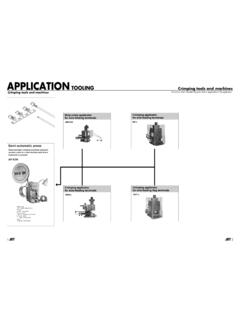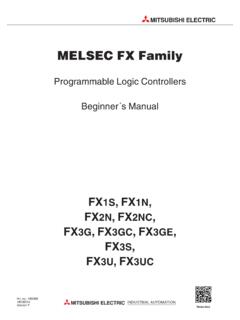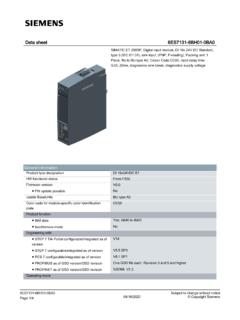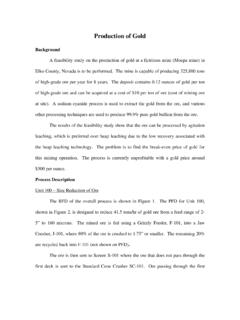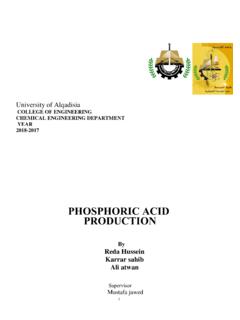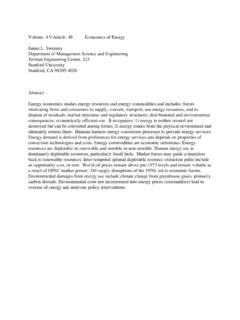Transcription of Thermocouple Selection Guide - RS Components
1 Thermocouple Selection (UK) (International)HeaderDiscover more Thermocouple Thermometry - At a Glance 60584-1 : 2013 / BS EN 60584-1 : 20131 for t < 1100 C,[1 + 0,003 x (t - 1100)] for t > 1100 CDiscover more of Sensor Types Thermocouple Platinum Resistance Thermometer Thermistor Sensor Thermoelement, two dissimilar metals/alloys Platinum-wire wound or flat-film resistor Ceramic (metal oxides) Accuracy (typical values) to C to C to C Long term Stability Variable, Prone to ageing Excellent Good Temperature range -200 to1750 C -200 to 650 C -100 to 300 C Thermal response Sheathed slow Exposed tip fast to 10 secs typical Wirewound slow Film faster 1-50 secs typical generally fast to secs typical Excitation None Constant current required None Characteristic Thermovoltage PTC resistance NTC resistance (some are PTC) Linearity Most types non-linear Fairly linear Exponential Lead resistance effect Short cable runs satisfactory 3 & 4 wire low.
2 2 wire high Low Electrical pick-up susceptible Rarely susceptible Not susceptible Interface Potentiometric input. Cold junction compensation required Bridge 2,3 or 4 wire 2 wire resistance Vibration effects/ shock Mineral insulated types suitable wirewound not suitable. Film good Suitable Output/ characteristic From 10 V/ C to to 40 V/ C depending on type approx. W/ C -4% / C Extension Leads Compensating cable Copper Copper Cost Relatively low cost Wirewound more expensive Film cheaper Inexpensive to moderate Comments and values shown in this chart are generalised and nominal. They are not intended to be definitive but are stated for general guidance. Discover more Thermocouple Junctions Sheathed Thermocouples Measuring Junctions Many alternative sheath materials are used to protect thermoelements, three alternative tip configurations are usually offered: An exposed (measuring) junction is recommended for the measurement of flowing or static non-corrosive gas temperature when the greatest sensitivity and quickest response is required.
3 An insulated junction is more suitable for corrosive media although the thermal response is slower. In some applications where more than one Thermocouple connects to the associated instrumentation, insulation may be essential to avoid spurious signals occurring in the measuring circuits. An earthed (grounded) junction is also suitable for corrosive media and for high pressure applications. It provides faster response than the insulated junction and protection not afforded by the exposed junction. Discover more Thermocouple TypesThe materials are made according to internationally accepted standards as laid down in IEC 584 1,2 which is based on the international Practical Temperature scale ITS 90.
4 Operating temperature maxima are dependent on the conductor thickness of the thermoelements. The Thermocouple types can be subdivided in 2 groups, base metal and rare (noble) metal: -200 C up to 1200 C These thermocouples use base metals Type K Chromel-Alumel: The best known and dominant Thermocouple belonging to the group chromium-nickel aluminium is type K. Its temperature range is extended (-200 up to 1100 C). Its temperature curve is reasonably linear and its sensitivity is 41 V/ C Type J Iron-Constantan: Though in thermometry the conventional type J is still popular it has less importance in Mineral Insulated form because of its limited temperature range, - 200C to +750 C. Type J is mainly still in use based on the widespread applications of old in struments calibrated for this type.
5 Their sensitivity rises to 55 V/ C. Type E Chromel-Constantan: Due to its high sensitivity (68 V/ C) Chromel-Constantan is mainly used in the cryogenic low temperature range (-200 up to +900 C). The fact that it is non magnetic could be a further advantage in some special applications. Type N Nicrosil-Nisil: This Thermocouple has very good thermoelectric stability, which is superior to other base metal thermocouples and has excellent resistance to high temperature oxidation. The Nicrosil-Nisil Thermocouple is ideally suited for accurate measurements in air up to 1200 C. In vacuum or controlled atmosphere, it can withstand temperatures in excess of 1200 C. Its sensitivity of 39 V/ C at 900 C is slightly lower than type K (41 V/ C).
6 Interchangeability tolerances are the same as for type K. Type T Copper-Constantan: This Thermocouple is used less frequently. Its temperature range is limited to -200 C up to +350 C. It is however very useful in food, environmental and refrigeration applications. Tolerance class is superior to other base metal types and close tolerance versions are readily obtainable. The curve is quite non-linear especially around 0 C and sensitivity is 42 V/ C. 0 C up to +1600 C Platinum-Rhodium (Noble metal) Thermocouples Type S Platinum rhodium 10% Rh-Platinum: They are normally used in oxidising atmosphere up to 1600 C. Their sensitivity is between 6 and 12 V/ C. Type R Platinum rhodium 13% Rh-Platinum: Similar version to type S with a sensitivity between 6 and 14 V/ C.
7 Type B Platinum rhodium 30% Rh-Platinum rhodium 6% Rh: It allows measurements up to 1700 C. Very stable Thermocouple but less sensitive in the lower range. (Output is negligible at room temperature). Historically these thermocouples have been the basis of high temperature in spite of their high cost and their low thermoelectric power. Until the launching of the Nicrosil-Nisil thermocouples, type N, they remained the sole option for good thermoelectric stability. Discover more or Surface Temperature Measurement Immersion Thermocouple assemblies are tip sensing devices which lends them to both surface and immersion applications depending on their construction. However, immersion types must be used carefully to avoid errors due to stem conduction; this is heat flow to or from the sheath and into or away from the process which can result in a high or low reading respectively.
8 A general rule is to immerse into the medium to a minimum of 4 times the outside diameter of the sheath; no quantitative data applies but care must be exercised in order to obtain meaningful results ( have regard for furnace wall thickness and such like). The ideal immersion depth can be achieved in practice by moving the probe into or out of the process medium incrementally; with each adjustment, note any apparent change in indicated temperature. The correct depth will result in no change in indicated temperature. Surface Temperature Measurement Although Thermocouple assemblies are primarily tip sensing devices, the use of protection tubes (sheaths) renders surface sensing impractical. Physically, the probe does not lend itself to surface presentation and stem conduction would cause reading errors.
9 If a Thermocouple is to be used reliably for surface sensing, it must be in either exposed, welded junction form with very small thermal mass or be housed in a construction which permits true surface contact whilst attaching to the surface. Locating a Thermocouple on a surface can be achieved in various ways including the use of an adhesive patch, a washer and stud, a magnet for ferrous metals and pipe clips. Examples of surface sensing thermocouples are shown below: Discover more of Sheath MaterialsSheath materials range from mild and stainless steels to refractory oxides (ceramics, so called) and a variety of exotic materials including rare metals. The choice of sheath must take account of operating temperature, media characteristics, durability and other considerations including the material relationship to the type of sensor.
10 Sheath Material Max Continuous Notes Applications Refractory Oxide recrystallised, Alumina Impervious 1750 C Good choice for rare metal thermocouples. Good resistance to chemical attack. Mechanically strong but severe thermal shock should be avoided. Forging iron & steel. Incinerators carburizing and hardening in heat treatment. Continuous furnaces. Glass Lehrs. Silicon Carbide (Porous) 1500 C Good level of protection even in severe conditions. Good resistance to reasonable levels of thermal shock. Mechanically strong when thick wall is specified but becomes brittle when aged. Unsuitable for oxidising atmospheres but resists fluxes. Forging iron & steel. Incinerators Billet heating, slab heating, butt welding.




